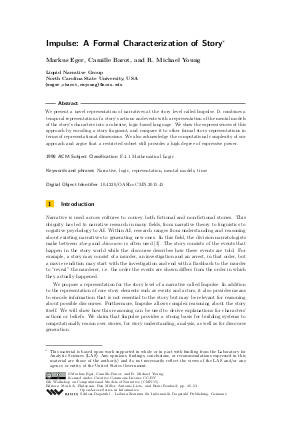Impulse: a Formal Characterization of Story
Authors Markus Eger, Camille Barot, R. Michael Young
-
Part of:
Volume:
6th Workshop on Computational Models of Narrative (CMN 2015)
Part of: Series: Open Access Series in Informatics (OASIcs) - License:
 Creative Commons Attribution 3.0 Unported license
Creative Commons Attribution 3.0 Unported license
- Publication Date: 2015-08-14
File

PDF
OASIcs.CMN.2015.45.pdf
- Filesize: 400 kB
- 9 pages
Document Identifiers
Subject Classification
Keywords
- Narrative
- logic
- representation
- mental models
- time
Metrics
- Access Statistics
-
Total Accesses (updated on a weekly basis)
0Document
0Metadata
Abstract
We present a novel representation of narratives at the story level called Impulse. It combines a temporal representation of a story’s actions and events with a representation of the mental models of the story’s characters into a cohesive, logic-based language. We show the expressiveness of this approach by encoding a story fragment, and compare it to other formal story representations in terms of representational dimensions. We also acknowledge the computational complexity of our approach and argue that a restricted subset still provides a high degree of expressive power
Cite As Get BibTex
Markus Eger, Camille Barot, and R. Michael Young. Impulse: a Formal Characterization of Story. In 6th Workshop on Computational Models of Narrative (CMN 2015). Open Access Series in Informatics (OASIcs), Volume 45, pp. 45-53, Schloss Dagstuhl – Leibniz-Zentrum für Informatik (2015)
https://doi.org/10.4230/OASIcs.CMN.2015.45
BibTex
@InProceedings{eger_et_al:OASIcs.CMN.2015.45,
author = {Eger, Markus and Barot, Camille and Young, R. Michael},
title = {{Impulse: a Formal Characterization of Story}},
booktitle = {6th Workshop on Computational Models of Narrative (CMN 2015)},
pages = {45--53},
series = {Open Access Series in Informatics (OASIcs)},
ISBN = {978-3-939897-93-4},
ISSN = {2190-6807},
year = {2015},
volume = {45},
editor = {Finlayson, Mark A. and Miller, Ben and Lieto, Antonio and Ronfard, Remi},
publisher = {Schloss Dagstuhl -- Leibniz-Zentrum f{\"u}r Informatik},
address = {Dagstuhl, Germany},
URL = {https://drops.dagstuhl.de/entities/document/10.4230/OASIcs.CMN.2015.45},
URN = {urn:nbn:de:0030-drops-52800},
doi = {10.4230/OASIcs.CMN.2015.45},
annote = {Keywords: Narrative, logic, representation, mental models, time}
}
Author Details
References
-
James F Allen. Maintaining knowledge about temporal intervals. Communications of the ACM, 26(11):832-843, 1983.

-
James F Allen and George Ferguson. Actions and events in interval temporal logic. Journal of logic and computation, 4(5):531-579, 1994.

-
Seymour Benjamin Chatman. Story and discourse: Narrative structure in fiction and film. Cornell University Press, 1980.

-
Philip R Cohen and Hector J Levesque. Intention is choice with commitment. Artificial intelligence, 42(2):213-261, 1990.

-
David K Elson and Kathleen R McKeown. A platform for symbolically encoding human narratives. In Proc. of the AAAI Fall Symposium on Intelligent Narrative Technologies, 2007.

-
Alfred Horn. On sentences which are true of direct unions of algebras. The Journal of Symbolic Logic, 16(01):14-21, 1951.

-
Arnav Jhala and Robert Michael Young. Cinematic visual discourse: Representation, generation, and evaluation. IEEE Transactions on Computational Intelligence and AI in Games, 2(2):69-81, 2010.

-
Vincenzo Lombardo, Cristina Battaglino, Antonio Pizzo, Rossana Damiano, and Antonio Lieto. Coupling conceptual modeling and rules for the annotation of dramatic media. Semantic Web Journal, Special Issue on Reasoning and Rule Systems, 2015.

-
Chris Martens, Joao F Ferreira, Anne-Gwenn Bosser, and Marc Cavazza. Generative story worlds as linear logic programs. In Proc. of the Seventh Intelligent Narrative Technologies Workshop, 2014.

-
John McCarthy and Patrick Hayes. Some philosophical problems from the standpoint of artificial intelligence. Stanford University USA, 1968.

-
Federico Peinado, Marc Cavazza, and David Pizzi. Revisiting character-based affective storytelling under a narrative bdi framework. In Interactive Storytelling, pages 83-88. Springer, 2008.

-
Mark O Riedl and R Michael Young. Story planning as exploratory creativity: Techniques for expanding the narrative search space. New Generation Computing, 24(3):303-323, 2006.

-
Mark O Riedl and Robert Michael Young. Narrative planning: Balancing plot and character. Journal of Artificial Intelligence Research, 39(1):217-268, 2010.

-
Ivo Swartjes and Mariët Theune. A fabula model for emergent narrative. In Technologies for Interactive Digital Storytelling and Entertainment, pages 49-60. Springer, 2006.

-
John Ronald Reuel Tolkien. The Lord of the Rings: One Volume. Houghton Mifflin Harcourt, 2012.

-
Tom Trabasso, Paul Van den Broek, and So Young Suh. Logical necessity and transitivity of causal relations in stories. Discourse Processes, 12(1):1-25, 1989.

-
Mischa M Tuffield, Dave E Millard, and Nigel R Shadbolt. Ontological approaches to modelling narrative. In Proc. of the 2nd AKT DTA Symposium, 2006.

-
Johan Van Benthem. Modal foundations for predicate logic. Logic Journal of IGPL, 5(2):259-286, 1997.

